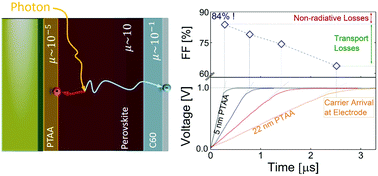Approaching the fill factor Shockley–Queisser limit in stable, dopant-free triple cation perovskite solar cells†
Abstract
Perovskite solar cells now compete with their inorganic counterparts in terms of power conversion efficiency, not least because of their small open-circuit voltage (VOC) losses. A key to surpass traditional thin-film solar cells is the fill factor (FF). Therefore, more insights into the physical mechanisms that define the bias dependence of the photocurrent are urgently required. In this work, we studied charge extraction and recombination in efficient triple cation perovskite solar cells with undoped organic electron/hole transport layers (ETL/HTL). Using integral time of flight we identify the transit time through the HTL as the key figure of merit for maximizing the fill factor (FF) and efficiency. Complementarily, intensity dependent photocurrent and VOC measurements elucidate the role of the HTL on the bias dependence of non-radiative and transport-related loss channels. We show that charge transport losses can be completely avoided under certain conditions, yielding devices with FFs of up to 84%. Optimized cells exhibit power conversion efficiencies of above 20% for 6 mm2 sized pixels and 18.9% for a device area of 1 cm2. These are record efficiencies for hybrid perovskite devices with dopant-free transport layers, highlighting the potential of this device technology to avoid charge-transport limitations and to approach the Shockley–Queisser limit.



 Please wait while we load your content...
Please wait while we load your content...